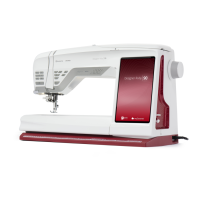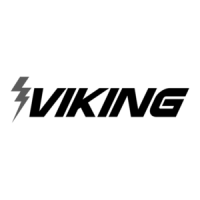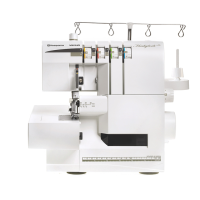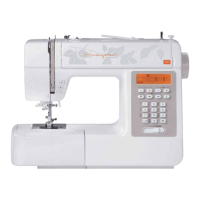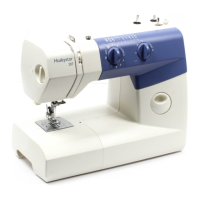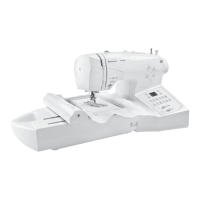Do you have a question about the Viking Designer I and is the answer not in the manual?
Critical warnings regarding electrical hazards and immediate risks.
Warnings about potential dangers like burns, fire, and personal injury.
Guidance on the maintenance and servicing of double-insulated products.
Guide on how to properly connect the sewing machine to a power source.
Instructions on how to safely pack away the sewing machine after use.
Detailed instructions for threading the upper thread through the machine.
Covers START/STOP, FIX, Reverse, and Needle stop up/down functions.
Details on Sensor Foot Lift (up, pivot, down) and pressure adjustment.
How to adjust sewing speed using the +/- SPEED buttons.
Function to cut threads and manage presser foot position.
Covers Presser Feet E, H, J, P, and their specific uses.
Basic operation of turning the screen on/off and setting up a screen saver.
Covers ADJUST, MENU, NORM, PROG, REP, SET, HELP for machine operation and settings.
How to select fabric type and weight within the Sewing Advisor.
How to select a sewing technique for automatic stitch setting.
Covers Menu A (Utility), Menu B (Buttonholes), and Decorative Menus C-N.
Includes Lettering, 4-Way, 8-Way, My Stitches, and Special Stitches menus.
How to view and load embroideries using the Embroidery Disk Icon.
Details on specific utility stitches available in Menu A.
Information on buttonhole stitches and recommended presser feet.
How to adjust the top thread tension for optimal stitch quality.
Adjusting presser foot pressure or setting pivot position for fabric handling.
Adjusting stitch balance for buttonholes and overall seam appearance.
Setting up features like FIX, Sensor Q-foot, and activating the Grid function.
Information on different types of sewing and embroidery threads.
Applying seam and overcast technique for ribbed neckbands and cuffs.
Steps for sewing buttonholes using the Sensor Buttonhole Foot.
Using the ruler to measure and determine buttonhole size.
Using a mending stitch to efficiently repair tears in fabric.
Detailed guide on using 4-way stitches for various sewing directions.
Details on the embroidery unit socket, arm, hoop attachment, and release button.
Description of the carrying case contents for storing embroidery accessories.
Step-by-step instructions for attaching and connecting the embroidery unit.
Rotating designs in 90-degree increments.
Flipping designs horizontally or vertically for creative effects.
Scaling embroidery designs up or down by a percentage.
Displaying and managing color sequences for embroidery designs.
Using the FIX function to baste outlines or secure stitches.
Sewing a design in a single color by disabling color stops.
Step-by-step guide to programming custom text designs.
Using FIX, Stitch Re-start, and STOP functions for decorative stitches.
Creating monograms using Outline block, Brush line, and Script lettering styles.
Programming first names and dates using mixed-case letters and numbers.
Stitching quilt blocks together quickly using the quilter's piecing stitch.
Using decorative stitches to tie quilts and create unique patterns.
Technique for joining lace or fabric as a row of embellishment.
Steps for inserting lace into fabric using utility stitches.
Step-by-step process for replacing the needle-side light bulb.
Step-by-step process for replacing the right-side light bulb.
Addresses poor tension, fabric puckering, and fabric not moving.
Solutions for skipped stitches, needle breaks, and related problems.
Troubleshooting bobbin thread breaks, alarms, and upper thread breaks.
Critical warnings regarding electrical hazards and immediate risks.
Warnings about potential dangers like burns, fire, and personal injury.
Guidance on the maintenance and servicing of double-insulated products.
Guide on how to properly connect the sewing machine to a power source.
Instructions on how to safely pack away the sewing machine after use.
Detailed instructions for threading the upper thread through the machine.
Covers START/STOP, FIX, Reverse, and Needle stop up/down functions.
Details on Sensor Foot Lift (up, pivot, down) and pressure adjustment.
How to adjust sewing speed using the +/- SPEED buttons.
Function to cut threads and manage presser foot position.
Covers Presser Feet E, H, J, P, and their specific uses.
Basic operation of turning the screen on/off and setting up a screen saver.
Covers ADJUST, MENU, NORM, PROG, REP, SET, HELP for machine operation and settings.
How to select fabric type and weight within the Sewing Advisor.
How to select a sewing technique for automatic stitch setting.
Covers Menu A (Utility), Menu B (Buttonholes), and Decorative Menus C-N.
Includes Lettering, 4-Way, 8-Way, My Stitches, and Special Stitches menus.
How to view and load embroideries using the Embroidery Disk Icon.
Details on specific utility stitches available in Menu A.
Information on buttonhole stitches and recommended presser feet.
How to adjust the top thread tension for optimal stitch quality.
Adjusting presser foot pressure or setting pivot position for fabric handling.
Adjusting stitch balance for buttonholes and overall seam appearance.
Setting up features like FIX, Sensor Q-foot, and activating the Grid function.
Information on different types of sewing and embroidery threads.
Applying seam and overcast technique for ribbed neckbands and cuffs.
Steps for sewing buttonholes using the Sensor Buttonhole Foot.
Using the ruler to measure and determine buttonhole size.
Using a mending stitch to efficiently repair tears in fabric.
Detailed guide on using 4-way stitches for various sewing directions.
Details on the embroidery unit socket, arm, hoop attachment, and release button.
Description of the carrying case contents for storing embroidery accessories.
Step-by-step instructions for attaching and connecting the embroidery unit.
Rotating designs in 90-degree increments.
Flipping designs horizontally or vertically for creative effects.
Scaling embroidery designs up or down by a percentage.
Displaying and managing color sequences for embroidery designs.
Using the FIX function to baste outlines or secure stitches.
Sewing a design in a single color by disabling color stops.
Step-by-step guide to programming custom text designs.
Using FIX, Stitch Re-start, and STOP functions for decorative stitches.
Creating monograms using Outline block, Brush line, and Script lettering styles.
Programming first names and dates using mixed-case letters and numbers.
Stitching quilt blocks together quickly using the quilter's piecing stitch.
Using decorative stitches to tie quilts and create unique patterns.
Technique for joining lace or fabric as a row of embellishment.
Steps for inserting lace into fabric using utility stitches.
Step-by-step process for replacing the needle-side light bulb.
Step-by-step process for replacing the right-side light bulb.
Addresses poor tension, fabric puckering, and fabric not moving.
Solutions for skipped stitches, needle breaks, and related problems.
Troubleshooting bobbin thread breaks, alarms, and upper thread breaks.
| Type | Electronic |
|---|---|
| Display | LCD |
| Built-in Needle Threader | Yes |
| Free Arm | Yes |
| Accessories Included | seam ripper, lint brush, screwdriver, bobbins |
| Presser Feet Included | Buttonhole Foot |
